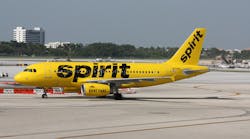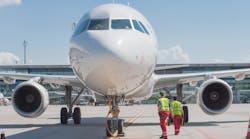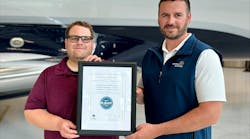When it comes to technology, knowledge and ease of use is true treasure, even for the ground handling profession.
Time and money are tight, as are the safety standards ground handlers must comply with. They are then told to follow individual and specific airline processes and service guidelines.
How does an organization stay ahead of it all? How do they afford it, in training, in finances, in simple hours of the day?
Technology companies have developed integrated solutions for many of these questions. Let’s see how.
Safety First
Terry Wickman, president of Keytroller LLC from Tampa, FL, says emerging technology is readily available for ground handlers. They just have to know where to look. They also need to be be open to finding new solutions as well as implementing them.
The company’s first product 19 years ago was a keypad ignition system for vehicles, which has evolved into a completely wireless unit with an LCD display that electronically allows for the OSHA daily checklist to be completed and for tasks to be sent to mechanics, dealers, supervisors, etc.
It also tracks usage hours to schedule regular maintenance on ground handling vehicles, and has sensors which prevent abusive operators, Wickman explains. He says the device is truly a vehicle management system and one that puts safety first, in a variety of ways.
“Everyone’s looking for ways to make equipment safer,” he notes. “How do you better plan for maintenance scheduling? They have to get these planes loaded and out, so each ground handling company may have its own buzzword at any given time.”
By this he means that one group may be looking to deal with speeding on vehicles, while another is looking for additional equipment usage information.
The company also has developed a variety of electronic devices for forklifts and mobile equipment monitoring, such as weigh scales and speed controllers, even directional control inhibitors. A camera can be used to also record abusive vehicle behavior when triggered by an incident such as a strong impact. Then a supervisor can receive the video in an email, and view the incident immediately.
Wickman says that pedestrian safety lights are another product which have a lot of potential in ground support circles.
“They’re used a lot on forklifts these days and are very, very effective,” he explains. “I haven’t seen them a lot in ground support, which is surprising as there are all kinds of people walking around the vehicles.”
The SlingBelt is another one of these products that technology has improved and helps keep ground handling personnel safe.
“The advantage is, if the person does not buckle it, it will flap in front and be annoying. But if he does (buckle it) and sits on it, it’s going to be real uncomfortable,” Wickman notes.
It doesn’t matter if a company is making steel or servicing airports and airlines, the buzzword on the ground and in the air is safety. Wickman says that with the multiple tiers of people in the airport/airline organizations, it’s hard for a company like his to get in front of the right people.
He recommends execs and technology buyers go to the trade shows, view new technologies and learn how they can be implemented. He adds reading trade magazines is a valuable way to gather information too.
“Our competitors are seeing the same thing,” he explains. “It’s hard to find the right guy who is the decision maker and get a meeting. Attend the major trade shows and you’ll see these new technologies in a quiet environment.”
Technology for Service Standards
As a ground handler himself before joining Amadeus, Yannick Beunardeau, director of Airport Solutions, knows the ins and outs of the industry. He is based in Nice, France, and oversees the development of the new generations of Amadeus products for airports and ground handlers.
They are in high demand and use, as Amadeus technology is being used by 130 airlines, 110 airports and 100 ground handlers worldwide.
Amadeus began in 1987, and always has been delivering these technology and IT services for the travel industries. He says the European independent ground handling industry boomed in the late 1990s due to deregulation, and so the company’s passenger service systems became the core of its ground handling technology tools.
Today, these trends are also growing in the United States and in South America.
Beunardeau says that each time a ground handling company accepts an airline for a client, they must conform to the tools and standards of that airline.
“So to service multiple airlines, means you also have to adopt multiple tools to help them, especially when checking passengers and loading aircraft,” he says.
The Amadeus Altéa Suite, a passenger service system, became very successful when it launched and has been welcomed by the ground handling community to help standardize those service tasks such as reservation, inventory, departure control and ticketing.
“In the United States, we’ve got Southwest Airlines and then British Airways, Air France, Japan Airlines, etc. using the same tool that we produced,” Beunardeau explains. “It was a big relief for ground handlers because when they need to host one of these airlines, it saves them a lot of money in terms of training and readiness.”
It makes sense, he adds, to use a tool that enables multiple airlines to process tasks the same way. The technology in the Altéa Suite, however, does allow for airline-specific parameters to be set that will differentiate things where desired. Beunardeau says that this system operates in the cloud, which allows ground handlers extreme flexibility when opening new stations or upgrading others.
“You just need to have a Wi-Fi connection to operate it,” he explains.
Additionally, Amadeus’ Airport Common Use Service (ACUS) is also cloud-based. He says that there are times airlines cannot be convinced to use the Departure Control System (DCS), but when additional resources are needed, he says the ACUS is an option. It enables the passenger processing systems to be deployed anywhere and on any device, over multiple airline clients. Each of Amadeus’ 100 ground handling clients uses this, and he calls it the “biggest switchboard of the world.”
Another system coming from Amadeus is the Baggage Reconciliation System (BRS) which is gaining popularity in the United States after considerable growth in Europe. He says that this is now being required by IATA because of the need to scan bags when they arrive at a destination airport.
“In the past, ground handlers needed to buy the best-of-breed for one system of each type, and it was one nightmare to integrate that all together,” says Beunardeau. “And they were spending a lot of money on integration.”
Dollars and Technology Sense
Continuity is something Beunardeau of Amadeus says saves costs too. He says that it can be difficult for ground handlers to keep up with rapidly changing and improving technology, just as it is in most industries.
He explains that spending money on integration is a waste, because it only means transferring data from Point A to Point B.
“I think it’s way better to spend IT money on systems, not transferring information,” Beunardeau says.
By subscribing to software as a service (SAS), it allows an organization to not be certified IT specialists. Instead the company can subscribe and benefit from a “community product,” he explains. With these types of products (similar to Microsoft’s Office 365), when a new function is available, it’s available for everyone who has the contract.
“If we develop and follow the trends of the industry, they will not be stuck with one version forever,” Beunardeau explains. “It’s our policy to continue to evolve the systems and make community products, never-ending evolutions of the same products.”
Wickman agrees, and explains Keytroller even offers lease-to-own agreements for a variety of products, or customers can try a demo for a period of time to see if the solution is the right fit.
“Customers can spread out the cost and still get the utilization of the products, without the big capital outlay,” he says.
Data-Driven Solutions
While all these products are promoting safety, service and savings, Keytroller's Wickman adds one thing which can’t be overlooked is the data that can be gathered and used to improve all those areas even further.
Keytroller’s CyberWatch LAN, for example, connects to any machine – whether a baggage conveyor or air conditioning unit – that a user may want to monitor. It is Wi-Fi enabled and the meters can be configured as alarms.
“How long did that air conditioner run, or the generator?” Wickman asks. “When you have that data coming in electronically, it’s really easy for ground handlers to look and say we need to get this part replaced, oil changed, etc.”
He says that once the hardware is purchased, the rest is automatic once it’s set up.
“One (unit) may be way overused and another hardly at all,” Wickman says. “With a monitor, ground handlers can see these things without physically going around a plane and finding the unit, and wondering which it is.
“It’s a way to make the job easier,” he concludes, adding that’s what technology is all about.








